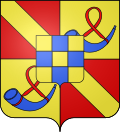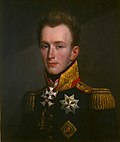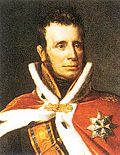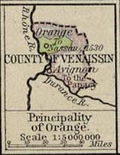Prince of Orange

Prince of Orange is a title of nobility.
The title is used by members of the House of Orange-Nassau, as heirs to the crown of the Netherlands. It also used by members of the House of Hohenzollern. At the moment, the title is used by Prince Willem-Alexander of the Netherlands (Orange-Nassau), Georg Friedrich, Prince of Prussia (Hohenzollern) and Guy, Marquis de Mailly-Neslé, Prince d'Orange.
The history of the title
The title was at first related to a self-ruling state called the Principality of Orange. It lies in the south of what we now call France. The land was the property of the house of Orange and from 1544 of the house of Orange-Nassau.
The last of the original princes, René of Nassau, left the principality to his cousin William the Silent after he died. William the Silent was not related to the original house of Orange, but was the legal heir.
In a war in 1673, Louis XIV of France took over the lands of the principality and added them to his own royal domain. This was part of the war against the stadtholder William III of Orange. Louis XIV then gave the principality to Louis of Mailly-Nesles, marquis of Nesles (1689–1764), a very remote relation of the original princes of Orange[source?]. His descendant still claims the title today. In 1714, Louis XIV allowed Prince Louis Armand of Bourbon-Conti to use the land of the Principality to make money. Prince Louis Armand died in 1727 and the principality was merged in the Crown in 1731.
William III died without legitimate children. This meant that the principality was seen as inherited by his closest cognate relative on the basis of the testament of Frederic-Henry, Frederick I of Prussia[source?]. He handed over the principality's lands but not the title to France in 1713. France supported his claim. In this way, the territory of the principality was no longer a separate state, but became a part of France. Through the Treaty of Utrecht. A new "Principality of Orange" was created by the King of Prussia as part of the duchy of Gelderland.[source?]. The kings of Prussia and the German emperors styled themselves Princes of Orange till 1918.
John William Friso of Nassau was chosen as the heir to the princes of Orange in the Netherlands by the last will of William III. John William Friso was also related to William the Silent through the female line. Several of his descendants became stadtholders. They claim the principality of Orange on the basis of agnatic inheritance (inheritance of lands to the brother rather than the sons of the king)[source?]. This way of inheriting is similar to the way William the Silent inherited from his cousin René. The claim to the title is also on basis of the testament of Philips William, Maurice and William III. Although they claimed the title "Prince of Orange", France never allowed them to obtain anything of the lands of the principality itself. It is from this tradition that later stadtholders of the Netherlands, and the present-day royal family of the Netherlands, also hold the title.
People with title Prince of Orange
As sovereign prince of Orange
Until 1340, it was customary for all sons of the prince of Orange to inherit the title. Only the direct line of descent to Raimond V is shown here.
House of Baux
| Picture | Name | Birth | Created Prince of Orange | Stopped to be Prince of Orange | Death | Other titles while Prince of Orange | Princess of Orange |
|---|---|---|---|---|---|---|---|

|
Prince Bertrand I | 1110/1115 | 1173 After the death of his brother-in-law, Raimbaut, Count of Orange, the County of Orange was made more important and became a principality and given to Bertrand I by the Holy Roman Emperor Frederick I. |
April/October 1180 | Lord of Baux | Tibors de Sarenom | |
House of Baux-Orange
| Picture | Name | Birth | Became Prince of Orange | Stopped to be Prince of Orange | Death | Other titles while Prince of Orange | Princess of Orange |
|---|---|---|---|---|---|---|---|
| Prince William I | 1155 | 31 October 1180 | bef. 30 July 1218 | Co-Prince (with brothers); Lord of Baux | 1. Ermengarde of Mévouillon 2. Alix | ||
| Prince William II | - | 31 October 1180 | bef. 1 November 1239 | Co-Prince (with brothers); Lord of Baux | Précieuse | ||
| Prince Raymond I | - | bef. 30 July 1218 | 1282 | Lord of Baux | Malberjone of Aix | ||
| Prince Bertrand II | - | 1282 | aft. 21 July 1314 | Lord of Baux | Eleanore of Geneva | ||
| Prince Raymond II | - | aft. 21 July 1314 | 1340, aft. 9 September | Lord of Baux and Condorcet | Anne of Viennois | ||
| Prince Raymond III | - | aft. 9 September 1340 | 10 February 1393 | Lord of Baux | 1. Constance of Trian 2. Jeanne of Geneva | ||
| Princess Mary | - | 10 February 1393 | October 1417 | Lady of Arlay, Cuiseaux, and Vitteaux | Prince John I | ||
House of Châlon-Arlay (also House of Ivrea of Anscarid dynasty)
| Picture | Name | Birth | Became Prince of Orange | Stopped to be Prince of Orange | Death | Other titles while Prince of Orange | Princess of Orange |
|---|---|---|---|---|---|---|---|

|
Prince John I | - | 10 February 1393 | October 1417 | 2 September 1418 | Lord of Arlay, Cuiseaux and Vitteaux | Princess Mary |

|
Prince Louis I | 1390 | October 1417 | 3 December 1463 | Lord of Arlay, Arguel, Orbe, and Echelens | 1. Jeanne of Montbéliard 2. Eleanor d'Armagnac 3. Blanche of Gamaches | |

|
Prince William II | - | 3 December 1463 | 27 September 1475 | Lord of Arlay and Arguel | Catherine of Brittany | |

|
Prince John II | 1443 | 27 September 1475 | 15 April 1502 | Count of Tonnerre; Lord of Arlay, Arguel and Montfaucon; Admiral of Guyenne. | 1. Jeanne de Bourbon 2. Philiberte of Luxembourg | |

|
Prince Philibert | 18 March 1502 | 15 April 1502 | 3 August 1530 | Viceroy of Naples; Prince of Melfi; Duke of Gravina; Count of Tonnerre, Charny, Penthièvre; Viscount of Besançon; Lord of Arlay, Nozeroy, Rougemont, Orgelet and Montfaucon, Lieutenant-General in the Imperial army. | no wife | |
House of Nassau
| Picture | Name | Birth | Became Prince of Orange | Stopped to be Prince of Orange | Death | Other titles while Prince of Orange | Princess of Orange |
|---|---|---|---|---|---|---|---|

|
Prince René | 5 February 1519 | 3 August 1530 | 15 July 1544 | Stadtholder of Holland, Zeeland, Utrecht and Guelders; Count of Nassau, and Vianden; Viscount of Antwerp; Baron of Breda, Diest, Herstal, Warneton, Beilstein, Arlay, and Nozeroy; Lord of Dasburg, Geertruidenberg, Hooge en Lage Zwaluwe, Klundert, Montfort, Naaldwijk, Niervaart, Polanen, Steenbergen, Bütgenbach, Sankt Vith, and Besançon. | Anna of Lorraine | |
House of Orange-Nassau (first creation)
As a personal title or as heir apparent
House of Orange-Nassau (second creation)
As personal title of nobility:
As royal title for the heir apparent:
| Picture | Name | Heir of | Birth | Became Heir to the Crown | Created Prince of Orange | Stopped to be Prince of Orange | Death | Other titles while Prince of Orange | Princess of Orange |
|---|---|---|---|---|---|---|---|---|---|

|
Prince William later William II |
William I | 6 December 1792 | 16 March 1815 father's accession as King |
7 October 1840 became King |
17 March 1849 | Prince of the Netherlands, Prince of Orange-Nassau | Grand Duchess Anna Pavlovna of Russia | |

|
Prince William later William III |
William II | 19 February 1817 | 7 October 1840 father's accession as King |
17 March 1849 became King |
23 November 1890 | Prince of the Netherlands, Prince of Orange-Nassau | Princess Sophie of Württemberg | |

|
Prince William | William III | 4 September 1840 | 17 March 1849 father's accession as King |
11 June 1879 | Prince of the Netherlands, Prince of Orange-Nassau | no wife | ||

|
Prince Alexander | 25 August 1851 | 11 June 1879 brother's death |
21 June 1884 | Prince of the Netherlands, Prince of Orange-Nassau | no wife | |||

|
Prince Willem-Alexander [1] |
Beatrix | 27 April 1967 | 30 April 1980 mother's accession as Queen regnant |
Incumbent | Prince of the Netherlands, Prince of Orange-Nassau, Jonkheer van Amsberg | Máxima Zorreguieta | ||
House of Hohenzollern
- Frederick I of Prussia (1702–1713), a senior descendant in female line from William the Silent, who ceded his claims to the lands of Orange to France in 1713, and his descendants, currently Georg Friedrich, Prince of Prussia, Prinz von Oranje (1976-)
House of Mailly
- Louis de Mailly, Marquis de Nesle et de Mailly, appointed by the French king, and his descendants, currently Guy, Marquis de Nesle and of Mailly, Prince d'Orange.
House of Bourbon
- Louis Armand de Bourbon, appointed by the French king, and his descendants. Louis Armand was also the Prince of Conti.
Prince Of Orange Media
Coat of arms of the counts of Orange of the first house of Orange. It came to stand for the principality of Orange. The homophony of the town's name with the fruit is a coincidence. The bugle-horn, supposedly derived from the first prince's surname "au Courb-nez" (curved-nosed or perhaps short-nosed), transformed into "au cornet" (with the bugle).
Map of the principality of Orange in the 16th century.
Related pages
References
- ↑ "Website Dutch Royal House on Willem-Alexander". Archived from the original on 2010-11-24. Retrieved 2011-03-23.
More reading
- Herbert H. Rowen, The princes of Orange: the stadholders in the Dutch Republic. Cambridge and New York: Cambridge University Press, 1988.
- Reina van Ditzhuyzen, Het Huis van Oranje: prinsen, stadhouders, koningen en koninginnen. Haarlem : De Haan, [1979].













